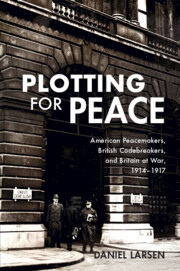Book contents
- Plotting for Peace
- Plotting for Peace
- Copyright page
- Dedication
- Contents
- Figures
- Map
- Graph and Table
- Dramatis Personae
- Preface
- Acknowledgements
- Maps
- Introduction
- 1 The First Year of War
- 2 Strategy
- 3 Negotiations
- 4 Deliberations
- 5 The Gamble
- 6 The Knock-Out Blow
- 7 The Fall of Asquith
- 8 Peace Moves
- 9 The Zimmermann Telegram and Wilson’s Move to War
- Conclusion
- Book part
- Notes
- Bibliography
- Index
9 - The Zimmermann Telegram and Wilson’s Move to War
February–April 1917
Published online by Cambridge University Press: 26 March 2021
- Plotting for Peace
- Plotting for Peace
- Copyright page
- Dedication
- Contents
- Figures
- Map
- Graph and Table
- Dramatis Personae
- Preface
- Acknowledgements
- Maps
- Introduction
- 1 The First Year of War
- 2 Strategy
- 3 Negotiations
- 4 Deliberations
- 5 The Gamble
- 6 The Knock-Out Blow
- 7 The Fall of Asquith
- 8 Peace Moves
- 9 The Zimmermann Telegram and Wilson’s Move to War
- Conclusion
- Book part
- Notes
- Bibliography
- Index
Summary
Wilson broke off diplomatic relations with Germany but began new peace efforts via Austria-Hungary. The new Austro-Hungarian Emperor Karl shared Wilson's desperation to open general peace negotiations. With the British down to their final tranche of American assets and yet refusing to cut their American spending, the Allies steadily grew more vulnerable to US pressure. Wilson pursued peace possibilities with Austria-Hungary, beginning indirect negotiations with the British leadership, who thought that an Austro-Hungarian separate peace might be on offer. These indirect negotiations led Lloyd George to make a reckless confession to the US Ambassador to London, Walter Page: Lloyd George confessed that he had secretly been reading Page's instructions from Washington. Page magnanimously kept this confession a secret. At the same time, British intelligence manouevred to make the best use of the Zimmermann Telegram. When Wilson received it, it had a dramatic effect on his diplomacy. Before, Wilson had consistently moved speedily and creatively to promote negotiations between London and Vienna. Afterward, he took a very hard line towards the Austro-Hungarians and broke off these peace negotiations despite large Austro-Hungarian concessions. Soon thereafter, the United States joined the First World War and provided massive financing to the Allies.
Keywords
- Type
- Chapter
- Information
- Plotting for PeaceAmerican Peacemakers, British Codebreakers, and Britain at War, 1914–1917, pp. 280 - 306Publisher: Cambridge University PressPrint publication year: 2021

